|
Indoor plants do more than that though. They help air quality because they give out oxygen that’s needed by us, whilst absorbing the carbon dioxide we exhale. Joseph Priestley demonstrated this beneficial arrangement between plants and animal life in the 1770s in his ‘bell jar’ experiment. He placed a live mouse in a sealed bell jar, completely on its own, and the poor thing perished in short order once the oxygen was used up. He then repeated his experiment, but this time he added sprigs of live mint to the jar. The mouse survived - as did the mint.
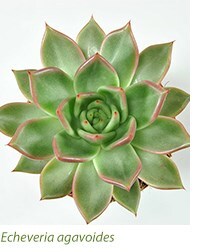 The BBC repeated the experiment using a human being in a television programme entitled ‘How to Grow a Planet’ in 2012. The brave volunteer was placed inside an airtight container in one of the biomes at the Eden Project in Cornwall. Oxygen levels rose steadily as 247 plants, including maize, banana, peace lily, ferns and mint, produced oxygen under artificial lights. The volunteer emerged fit and well, after 48 hours. It proves that house plants are more than purely decorative: they enhance the air. The BBC repeated the experiment using a human being in a television programme entitled ‘How to Grow a Planet’ in 2012. The brave volunteer was placed inside an airtight container in one of the biomes at the Eden Project in Cornwall. Oxygen levels rose steadily as 247 plants, including maize, banana, peace lily, ferns and mint, produced oxygen under artificial lights. The volunteer emerged fit and well, after 48 hours. It proves that house plants are more than purely decorative: they enhance the air.
Choose Wisely
The trick is choosing the right one, for some thrive in cool conditions and others love the heat. Some prefer shade and others like to bask. Whatever you choose though, there are five golden rules when it comes to keeping happy house plants. - Never place a plant on a sunny windowsill, even cacti and succulents find the magnified glare too much. Give them a bright position in good light.
- Ambient temperatures that don’t vary wildly are best and keep them away from drafts.
- Water sparingly in winter, but more often in summer.
- Feed flowering houseplants with tomato feed (a potash-rich fertiliser) during the growing season.
- Re-pot in spring if needed, using John Innes no 2 in most cases.
Go for a Tropical Look
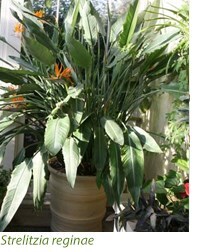 The showy Bird of Paradise plant, Strelitzia reginae, produces exotic flowers between February and May. It’s not exactly for the windowsill, because it’s too substantial, so this one’s best on a floor in a space where it can shine. It’s an ideal plant for a heated conservatory for instance. An architectural plant, it comes from the southern and eastern parts of the Cape Province and northern Natal in South Africa, but it’s been grown at Kew since 1773. Sir Joseph Banks collected it and named it after Queen Charlotte, wife of George III, who lived at Kew Palace. You can cut the flowers, but if it’s allowed to produce fruits, which are black with a frilly orange aril, they are almost as exotic as the violet and orange-crested flowers. The showy Bird of Paradise plant, Strelitzia reginae, produces exotic flowers between February and May. It’s not exactly for the windowsill, because it’s too substantial, so this one’s best on a floor in a space where it can shine. It’s an ideal plant for a heated conservatory for instance. An architectural plant, it comes from the southern and eastern parts of the Cape Province and northern Natal in South Africa, but it’s been grown at Kew since 1773. Sir Joseph Banks collected it and named it after Queen Charlotte, wife of George III, who lived at Kew Palace. You can cut the flowers, but if it’s allowed to produce fruits, which are black with a frilly orange aril, they are almost as exotic as the violet and orange-crested flowers.
Like many South African plants from the eastern half of the Cape, Strelitzia enjoys lots of water in summer and drier conditions in winter. Temperatures of around 20C suit it well, but the flower set will relate to how much summer moisture it gets. A conservatory is ideal, but this frost-tender plant can be placed outside in summer - but do water it copiously in dry summers if you want it to flower well.
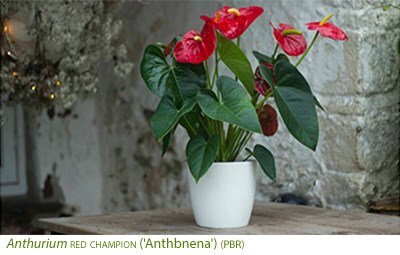
Flamingo flowers, or anthuriums, look almost as exotic as strelitzias, but these compact plants fit into the home more easily. The glossy foliage is almost spoon-like and the stems are topped with colourful arum-like bracts often in vivid shades such as red and pink. These surround a finger (or spadix) of small flowers. They grow in warmer parts of America, Mexico and the Caribbean so give them a light position during the winter months where they're out of direct sunlight, and their flower-like bracts will give you weeks of interest. They will need a period of dormancy after flowering, so stop watering, and after six weeks they’ll start off all over again.
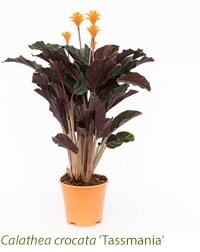 Calatheas, or Peacock plants, also come from the tropical Americas but they are normally grown for their highly patterned foliage. ‘Medallion’ has red-backed foliage but then upper sides are almost frosted in shades of jade and white so these plants are often known as Zebra plants as well. Calathea crocata ‘Tassmania' though is grown for its flamboyant orange flowers that are set against dark purplish foliage. Calatheas, or Peacock plants, also come from the tropical Americas but they are normally grown for their highly patterned foliage. ‘Medallion’ has red-backed foliage but then upper sides are almost frosted in shades of jade and white so these plants are often known as Zebra plants as well. Calathea crocata ‘Tassmania' though is grown for its flamboyant orange flowers that are set against dark purplish foliage.
The Gin and Tonic Option
Having your own lemon tree is always an attractive proposition and many gardeners are partial to the gin and tonic too. The easiest lemon tree to grow is the Four Seasons lemon, 'Gareys Eureka’, because this self-fertile lemon is very willing to produce fruit and will not need another lemon tree to do so. The white flowers are fragrant early in the year and this variety is hardier than many other lemons, although it will need winter protection in cold weather. Fleece and a frost-breaking heater will stop this tender plant from succumbing to frost.
An Exotic Fragrance
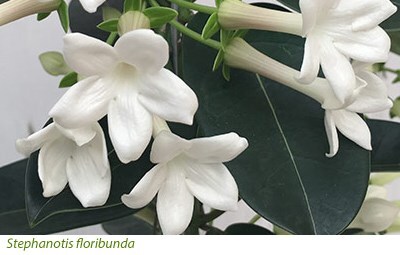
Scent is always desirable and Stephanotis floribunda, the Madagascar jasmine, provides lush green foliage and highly scented white flowers on a neat plant that can be grown in a small pot on a windowsill. However as it matures it could scale a 2m high warm wall when trained on a framework or on wires. The waxy foliage is an indicator that this plant will enjoy good light, but not full sun, with an ambient warm temperature of 20C. A centrally heated room can be ideal. Keep the compost moist in summer and only just moist in winter. Tidy after flowering.
Frost-Tender Orchids
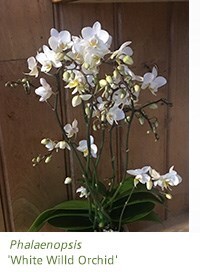 Orchids prefer cool temperatures (of roughly 10C) and a position away from full sun, because many grow at high altitude in cooler, cloudier conditions. Once horribly expensive and now much cheaper, due to micropropagation techniques, tender orchids are perfect for shadier, north-facing windowsills. In summer the light will brighten, because the sun sets in the north west, and temperatures will rise to 18C in summer. Then flowers will be produced. Cymbidiums are the easiest of all to grow, with strappy foliage and showy often-pink flowers. 'Peggy Sue’ produces twenty or so flowers per stem, in raspberry-pink, and three stems are produced on this compact plant. The lips of the flowers are heavily spotted, so they look very exotic. Water very carefully, once the compost feels dry, and spray the foliage with water once a week - to recreate those mountain mists. Orchids prefer cool temperatures (of roughly 10C) and a position away from full sun, because many grow at high altitude in cooler, cloudier conditions. Once horribly expensive and now much cheaper, due to micropropagation techniques, tender orchids are perfect for shadier, north-facing windowsills. In summer the light will brighten, because the sun sets in the north west, and temperatures will rise to 18C in summer. Then flowers will be produced. Cymbidiums are the easiest of all to grow, with strappy foliage and showy often-pink flowers. 'Peggy Sue’ produces twenty or so flowers per stem, in raspberry-pink, and three stems are produced on this compact plant. The lips of the flowers are heavily spotted, so they look very exotic. Water very carefully, once the compost feels dry, and spray the foliage with water once a week - to recreate those mountain mists.
Moth orchids, or Phalaenopsis, have low-growing rounded leaves that arch over the pot and the flat-faced flowers are held on tall, strong stems. This gives them an elegant profile and the flowers will last for many months. Water sparingly, by picking up the pot and allowing the tap to run through for a mere second or two.
Never, ever allow any tender orchid to sit in water, so if it’s in a cache pot always let the water drain away before you put it back into the pot. Moth orchids develop aerial roots when happy, so take care not to damage them. Spray with a mister once a week and, if kept in a bright coolish place moth orchids will re-bloom in subsequent years IF you cut the spent stems back to between six and nine inches, to the second lowest buds. Orchid food comes in aerosol form and moth orchids like to be fed. ‘White Willd Orchid’ is a very floriferous form the pristine white flowers look superb in a gold cache pot.
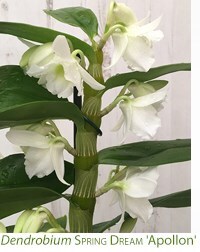 Dendrobium ‘Spring Dream’ (Apollon) has thick fleshy stems that produce pairs of leaves alternately spaced all the way up. The single flowers appear on the stems opposite each leaf, and this arrangement is found on all soft-caned dendrobiums. Hard-caned dendrobiums produce sprays of flower from the top. Both forms lack the simple elegance of moth orchids. Dendrobiums need to be kept cool and on the dry side in winter (5- 10C) because this cool period initiates flowering. They resent direct sunlight and a north-facing or west-facing windowsill works best. However in the growing season they enjoy lots of humidity so a daily spray of water is an excellent idea. They grow as summer arrives and should be fed with an orchid food. Dendrobium ‘Spring Dream’ (Apollon) has thick fleshy stems that produce pairs of leaves alternately spaced all the way up. The single flowers appear on the stems opposite each leaf, and this arrangement is found on all soft-caned dendrobiums. Hard-caned dendrobiums produce sprays of flower from the top. Both forms lack the simple elegance of moth orchids. Dendrobiums need to be kept cool and on the dry side in winter (5- 10C) because this cool period initiates flowering. They resent direct sunlight and a north-facing or west-facing windowsill works best. However in the growing season they enjoy lots of humidity so a daily spray of water is an excellent idea. They grow as summer arrives and should be fed with an orchid food.
Streptocarpus make excellent companions to orchids, because they enjoy the same conditions. A light windowsill away from direct sunlight is ideal and I have seen large collections thriving on north-facing windowsills during summer. However they should be moved to a warmer position during winter because if the temperature falls to below 13C flowering stops immediately.
Streptocarpus are soft stemmed and they should be sparsely watered in winter because plants can and do rot away if too wet. Up the watering as spring arrives and feed them with a high-potash plant food, such as tomato feed, every two weeks and stems of dainty flowers will soon follow. ‘Crystal Ice’ has soft grey-blue flowers blotched in deep-blue. Streptocarpus foliage can be very handsome, but the leaves scorch and brown in dry air and full sun, so standing your plant on a bed of pebbles adds extra humidity, something these South African woodlanders enjoy.
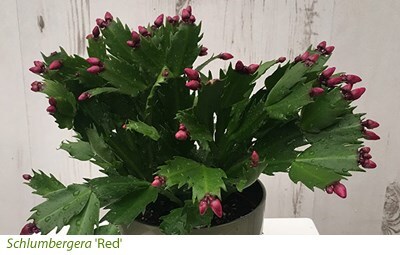
The Christmas cacti, Schlumbergera is a popular favourite with its almost sci-fi arrangement of sectioned foliage and shrimp-like flowers. However this plant needs dark, long nights in autumn in order to flower well so tuck it behind the curtains as we come up to the shortest day. Once it’s in flower leave it in its position for it’s said that turning makes the buds drop. When summer arrives move it from its bright sunny position. Water with rainwater rather than tap water, which tends to be too alkaline, and keep the compost moist rather than wet until the plant has finished flowering. Then allow it to dry out. If you repot, use ericaceous compost. |
Things to do
| |
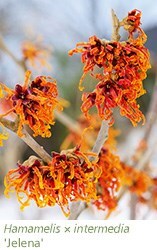
If you have witch hazels in flower, these lovers of deep and fertile soil will flower better if the new growth at the top of each stem is pinched back, by a few inches, with your finger tips. It’ll encourage more side shoots and more flower.
|
| |

Roses should be pruned within the next few weeks, but only if the weather’s clement. Use good secateurs, such as Felco no 2s, and begin by looking for dead, dying and diseased wood which is very visible now. If two branches are rubbing together, or crossing, cut the weakest away. Then aim for an open shape consisting of roughly five strong branches. Floribunda roses are cut back to eighteen inches. Hybrid teas can go lower, to roughly six to nine inches, and shrub roses generally have their stems reduced by a third. Good pruning creates an airy shape, so the rose is less prone to disease, and it encourages vigour in the spring.
|
| |
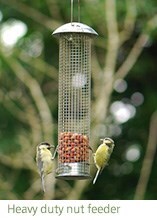
Keep feeding the birds because smaller birds can be decimated by hard winters. You’ll get an array of birds passing through in winter.
|
| |

Cover up your rhubarb so that you get some delicious pink stems in the next few weeks. A rhubarb forcer is an elegant addition.
|
| |

Wash pots and seed trays whenever the weather’s encouraging, using warm washing up water.
|
|

















